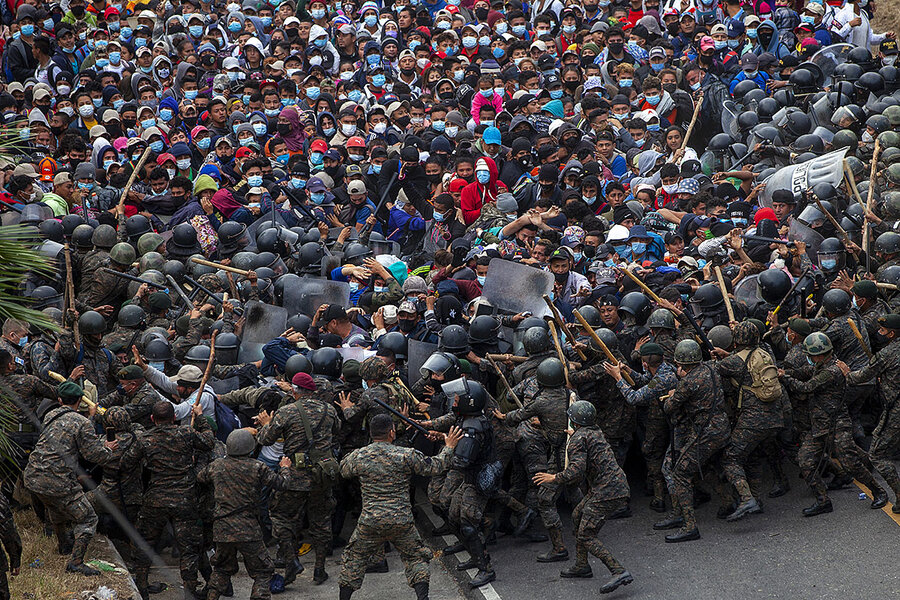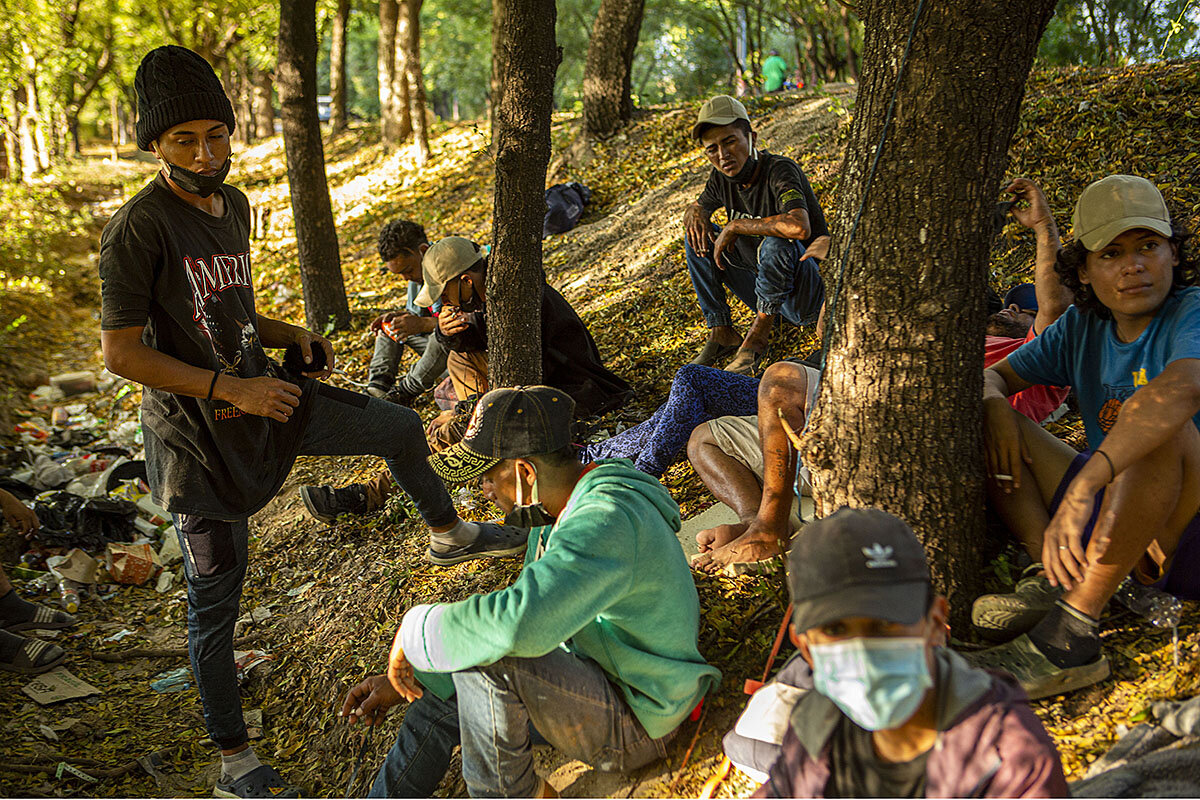The caravan hoped for change. But it’s not all up to Biden.
Loading...
| Vado Hondo, Guatemala; and Mexico City
On Jan. 18, near the border between Guatemala and Honduras, police and troops in riot gear effectively disbanded a migrant caravan – thousands of Hondurans attempting to trek north to the U.S.
It was the kind of scene some migrants had expected to disappear once Joe Biden was in the White House. Historically, U.S. immigration policy has strongly informed its neighbors’. And over the past four years, the Trump administration emphasized containment, effectively pressuring Mexico and Guatemala to keep migrants and asylum-seekers far from its border.
Why We Wrote This
Mexico and Guatemala toughened up border policies under pressure from Donald Trump. But they may have their own reasons to stick with the new status quo. No matter who’s in the White House, migration challenges aren’t going away.
But despite some quick actions on immigration during President Biden’s first week in office, it’s unclear how immigration enforcement might shift in the region. Containment is “easy,” says Gretchen Kuhner, director of the Institute for Women in Migration in Mexico City. “It’s not as messy as trying to interview people and help them get protection.”
Fernando Castro, a former vice consul at the Guatemalan Consulate in Chiapas, Mexico, welcomes news of a new U.S. aid package to address root causes of migration. But such efforts need to be closely assessed to see what actually works, he stresses, and regional governments need to band together to sort out their shared interests.
“Migration is going to continue,” he says.
Two Honduran women pleaded with an immigration official last week, after walking into Guatemala with the estimated 8,000-strong migrant caravan that left Honduras earlier this month.
“I’m a single mother,” one of the young women told the Guatemalan official, her voice breaking. “You are eating well. We do not even have bananas because the river swept away all our crops, all our means to work.” She had already traveled more than 250 miles from her home in Yoro, devastated by back-to-back hurricanes last fall, and even before that suffering high unemployment and violent crime.
The official was sympathetic, but repeated Guatemala’s policy of requiring a negative COVID-19 test in order to enter. He would have to send them back across the border.
Why We Wrote This
Mexico and Guatemala toughened up border policies under pressure from Donald Trump. But they may have their own reasons to stick with the new status quo. No matter who’s in the White House, migration challenges aren’t going away.
The women pushed back: Hadn’t he heard the news? The caravan was going to get help along the way. Joe Biden promised that once he was in office the caravan would be welcome in the United States and free to travel through Mexico.
The false rumors underscore common expectations for change as the Biden administration takes control, though migrants’ motivations for fleeing home had little to do with the inauguration. Over the past four years, the U.S. approach to migration has brushed over root causes to emphasize containment, effectively pressuring Mexico and Guatemala to keep migrants and asylum-seekers from continuing north.
But despite some quick actions during President Biden’s first week in office – including the suspension of new admissions to the Migrant Protection Protocols (MPP) policy, which forced asylum-seekers to remain in Mexico awaiting U.S. court hearings – it’s unclear how immigration enforcement might shift in the region. Historically, U.S. policy on migration has strongly informed its neighbors’. Yet containment is easier than a holistic approach that might require increased budgets and public policies, observers say.
In the past two years, Mexico’s president went from promising more humanitarian visas for migrants to deploying the national guard to keep them out, under pressure from President Donald Trump. Guatemala, one of the biggest sending countries of migrants to the U.S. in recent years, agreed to take in asylum-seekers from other countries during Mr. Trump’s administration, and met the most recent migrant caravan with force, barring the group from advancing toward the U.S. Mexico and the U.S. thanked Guatemala for its efforts.
“We know Donald Trump essentially forced this situation,” says the Rev. Mauro Verzeletti, director of the Casa del Migrante shelter in Guatemala City, speaking of Mexico and Guatemala’s increasingly militarized attempts to halt northbound migration. But he isn’t confident there will be an about-face under Mr. Biden.
“Making declarations and repressing people is easy,” says Mr. Verzeletti. Addressing the root causes that put people in such desperate conditions to begin with, he says, takes more resources, will, and work.
Passing through
Historically, Mexico hasn’t had a true migration policy of its own, says María Dolores París Pombo, a professor at the College of the Northern Border outside Tijuana. Instead, it tends to react directly to directives and policies in the U.S.
She says Mexico has taken some of its most notable moves around migration at key moments in U.S.-Mexico relations. Mexico created its national migration institute in 1993, for example, in the lead-up to NAFTA. And it launched an initiative to cut off key flows of migration from Guatemala in 2001, before U.S. and Mexican presidents met to discuss immigration reform. Mexico militarized its southern border after President Barack Obama declared a humanitarian crisis over unaccompanied minors arriving at the U.S. border in 2014.
“Mexico isn’t a country of immigration like the U.S. It’s more a country of transit,” says Dr. París Pombo, but “the policies the U.S. adopts directly affect Mexico.”
Gretchen Kuhner, the director of the Institute for Women in Migration in Mexico City, says Mexico has national interests of its own in keeping levels of migration down. On Inauguration Day, Mr. Biden introduced the U.S. Citizenship Act, which could create a path to citizenship for some 11 million immigrants without legal status. He also issued an executive order to bolster the Deferred Action for Childhood Arrivals program, calling on Congress to enact legislation to provide permanent legal status or citizenship for so-called Dreamers, the vast majority of whom are Mexican.
“Mexico knows very well that if there’s a surge on the border, the political right in the U.S. will make a huge issue of it, and that could impact the legislative proposals for immigration,” says Ms. Kuhner. “That plays into Mexico’s approach.”
Guatemala may be thinking along similar lines: Remittances sent home to Guatemala by relatives in the U.S. reached record levels during the pandemic, surpassing $1 billion a month by the end of 2020. That’s a lifeline few Guatemalan officials want to jeopardize.
Containment is also “easy,” says Ms. Kuhner. “It’s not as messy as trying to interview people and help them get protection.”
Because of U.S. policies like MPP, Mexico has many more migrants waiting long term than before. “These are really vulnerable people and Mexico doesn’t have policies for this,” says Dr. París Pombo. “Even with MPP suspended, this isn’t going to be resolved in the short term. And I don’t think governments – neither Guatemala nor Mexico – are going to modify their current approaches. They don’t have the capacity,” she says. “They’d prefer to put the Army on their borders, detain people, and return them to their country, instead of having to take charge of them.”
“Going to continue”
Guatemalan security forces blocked a road near Vado Hondo Jan. 16, holding back thousands of mostly Honduran migrants en route to the U.S., and soldiers used batons on a group that pushed through. Two days later, hundreds of police and troops in riot gear cleared the highway, effectively disbanding the caravan. Mexico deployed additional troops along its own southern border in anticipation, though the caravan wound up splintering long before.
At an immigration checkpoint in nearby Rio Hondo, it became clear the only option was to turn back. With armed forces looking on, migrants, including many young children, waited to board buses home.
Pascual Cálix was one of them. Forced to leave his home in Honduras following hurricanes Eta and Iota, he’d joined the caravan to find work in the U.S. in order to support his wife and teenage son, repair his damaged property, and replant the land on which his family depends for food.
“There has been no help from the government,” he says of Honduras’ response to the double whammy of natural disasters late last year, which impacted hundreds of thousands of people.
“The U.S. sends aid to [Honduras], but [to] the poor, nothing,” Mr. Cálix laments. He hasn’t ruled out trying to migrate again.
Mexican President Andrés Manuel López Obrador said last week that President Biden had pledged $4 billion in a phone call for development in Honduras, El Salvador, and Guatemala, where crime, unemployment, and other hardships have generated a steady stream of migration up to the U.S. border.
Fernando Castro, former vice consul at the Guatemalan Consulate in the Mexican state of Chiapas from 2017 to 2020, applauds Mr. Biden’s plan to create an aid package for Central America. But he hopes it’s carried out differently from previous efforts, like a similar aid package deployed under Mr. Obama that Mr. Castro says “really did not work.”
Job creation should be a key focus, he says, but there need to be regular assessments to see what actually reduces migration and what does not. He also thinks regional governments need to band together to sort out their shared interests, particularly dealing with seasonal migration within the region.
“Migration is going to continue,” he says.
Some people, including human smugglers, are taking advantage of people’s hopes that the situation at the U.S. border will become more welcoming.
But, along the route north, Mr. Castro warns, “the same position that Donald Trump left [behind] is being upheld.”









